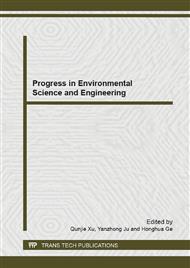p.1343
p.1349
p.1354
p.1359
p.1364
p.1368
p.1372
p.1377
p.1383
Study of Degradation of Phenol by Fenton Reagent under Sunlight
Abstract:
Degradation of phenol was studied in the presence of Fenton Reagent. The initial concentrations of C2O42, H2O2 , Fe2 + and pH value on the reaction were investigated. The optimum conditions to degrade phenol from water were determined when initial phenol concentration was 500mg/L, the concentration of Na2C2O4, H2O2 and Fe2 + were 0mmol/L, 300mg/L and 60mg/ L respectively, and pH value was 3. Under the optimum conditions, phenol degradation and mineralization rates could reach 80% and 50%, respectively when the degrade time lasted 10 min.Reference to other literature of sodium oxalate to join can effectively improve the utilization of the ultraviolet and visible light,thus enhancing the effect of high concentrations of phenol wastewater removal, but this experiment reflects the high C2O42- will play an inhibitory effect .
Info:
Periodical:
Pages:
1364-1367
Citation:
Online since:
December 2012
Authors:
Keywords:
Price:
Сopyright:
© 2013 Trans Tech Publications Ltd. All Rights Reserved
Share:
Citation:


